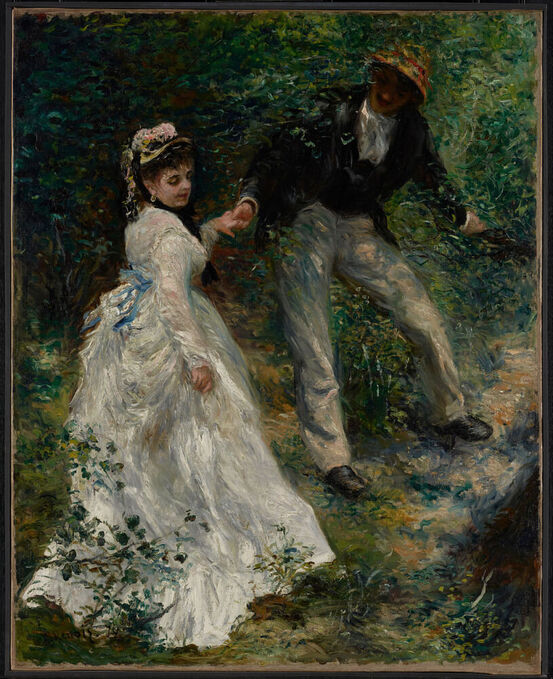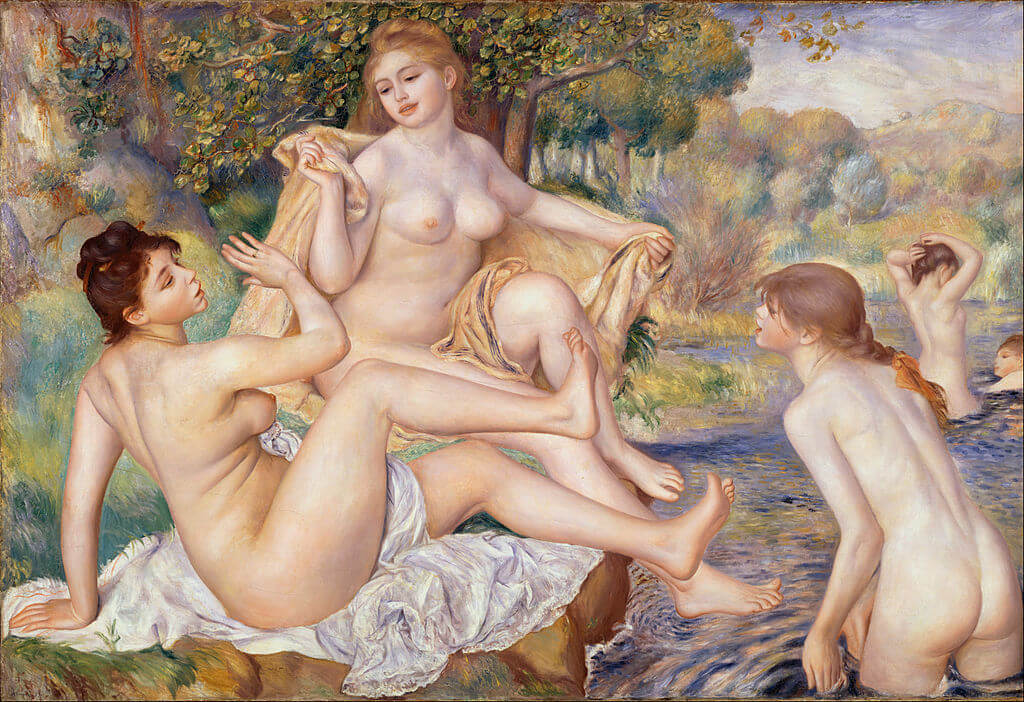|
Where? Room W204 of the J. Paul Getty Museum
When? 1870 What do you see? Two well-dressed people are depicted in a green landscape, probably a forest or park near Paris. On the left is a somewhat shy woman in a long white dress (no, the white dress is not stained like an art critic from that time said, but it is the trademark Impressionist painting style). he man on the right wears a somewhat informal, but neat set of clothes and a brown hat with a red ribbon around it. He holds the hand of the woman to guide her through the dense, uncultivated terrain. With his left arm, he pushes the bushes aside such that they can continue on the small path they are walking. The woman slightly lifts her white dress and has her head turned over her right shoulder as if she is hesitant to continue down the path. There seems to be some love connection between the two. The couple is enjoying a relaxed stroll through the landscape, and the painting technique of Renoir makes them blend into the landscape. Renoir used the light in this painting to emphasize the presence of the woman and the path through the forest. The man is standing in the shadow and only parts of his pants, hands, collar, and hat capture some sunlight. Backstory: In 1989, the Getty Museum paid $17.7 million to acquire this painting. The title of the painting is La Promenade, which means ‘the walk’. However, it is not certain whether Renoir gave this title to the painting or whether it was given later on by auctioneers. This painting is a direct result of his interactions with Claude Monet, who had advised him in 1869 to use lighter colors. Monet himself also used lighter colors, and you can see some of the similarities between this painting by Renoir and Woman with a Parasol - Madame Monet and Her Son by Monet in 1875, which is in the National Gallery of Art.
The birth of Impressionism: In the 1860s, in France, the government and the powerful art institutions were in control of the type of art that was exhibited. The artists paid a lot of attention to the details and finish of their works. Under the lead of Édouard Manet, a group of artists changed their style to what we now call Impressionism. Manet hosted a twice-weekly meeting with painters such as Cézanne, Degas, Monet, Pissarro, Renoir, and Sisley.
Among other things, the Impressionists wanted to capture quick, transitory moments in time. To do that, they changed the technique of painting. Before, different layers of paint were applied on top of each other, with long waiting times in between each layer to make sure each layer dried properly. Impressionists, however, wanted to paint their observations in a single session and had to immediately apply the right color of paint to the canvas as they could not resort to the underlying layers to create the perfect color. Who is Renoir? Pierre-Auguste Renoir (1841-1919) was a French impressionist artist. He is often referred to simply as Auguste Renoir and he also signed this painting with A. Renoir. He was a talented singer and wanted to become a professional singer when he was young. However, as singing was a risky career, he switched to painting in which he was also talented. His early work was inspired by Manet and Pissarro, and by his friend and contemporary, Claude Monet. By 1879, Renoir was considered to be a successful painter, and he took some time to travel around Europe and North Africa to become familiar with the works of Delacroix, Raphael, Titian, and Velázquez. Some of his famous works include A Girl with a Watering Can in the National Gallery of Art and The Large Bathers in the Philadelphia Museum of Art.
Fun fact: The man is this painting is probably Alfred Sisley, a British impressionist painter who lived most of his life in France. Sisley was a friend of Renoir. They met in art school in Paris in 1862.
The model for the woman in this painting is probably Lise Tréhot. She had a relationship with Renoir and served as a female model for almost all his paintings between 1866 and 1872. While not a lot is known about the exact nature of their relationship, they may have gotten two children together. The first may have died as an infant. In 1868 Lise gave birth to a girl, Jeanne, who was given away to a nurse. Indirect evidence that this was the child of Renoir as well is that he secretly provided financial support to Jeanne during his life, even though he has never publicly acknowledged her as his child. Interested in a copy for yourself? Poster
Written by Eelco Kappe
References:
0 Comments
Leave a Reply. |
Categories
All
|
- Home
- Blog
-
Museums
- Alte Pinakothek
- Art Institute of Chicago
- Baltimore Museum of Art
- Barber Institute of Fine Arts
- Bargello
- Barnes Foundation
- British Museum
- Church of Sant’Anastasia
- Cleveland Museum of Art
- Courtauld Institute of Art
- Detroit Institute of Arts
- Frans Hals Museum
- Galleria Borghese
- Gallerie dell'Accademia
- Getty Museum
- Guggenheim
- Hermitage Museum
- Kunsthistorisches Museum
- Kunstmuseum Basel
- Legion of Honor Museum
- Louvre
- Mauritshuis
- Metropolitan Museum of Art
- Musee d’Orsay
- Museum of Fine Arts in Boston
- Museum of Modern Art
- National Gallery in London
- National Gallery of Art
- National Museum in Poznań
- Norton Simon Museum
- Ny Carlsberg Glyptotek
- Palace of Versailles
- Palazzo Pitti
- Palazzo Vecchio
- Petit Palais
- Philadelphia Museum of Art
- Prado
- Pushkin Museum
- Ravenna Art Museum
- Rijksmuseum
- San Diego Museum of Art
- Santa Maria delle Grazie
- St. Peter's Basilica
- Städel Museum
- Statens Museum for Kunst
- Tate Britain
- Tate Modern
- Timken Museum of Art
- Uffizi
- Vatican Museums
- Wallace Collection
-
Artists
- Altdorfer
- Anguissola
- Berlin Painter
- Bosch
- Botticelli
- Boucher
- Bronzino
- Bruegel the Elder
- Brunelleschi
- Cabanel
- Caillebotte
- Canova
- Caravaggio
- Carpeaux
- Cezanne
- Cimabue
- David
- Degas
- Delacroix
- De Maria
- Donatello
- El Greco
- Fontana
- Fra Angelico
- Fragonard
- Gauguin
- Gentileschi
- Gericault
- Gonzalez-Torres
- Goya
- Hals
- Hogarth
- Hokusai
- Ingres
- Leonardo da Vinci
- Lippi, Filippo
- Longhi, Barbara
- Lorrain
- Makovsky
- Manet
- Massys
- Matisse
- Merian
- Michelangelo
- Mochi
- Modigliani
- Monet
- Panini
- Parmigianino
- Perugino
- Picasso
- Pisanello
- Raphael
- Rembrandt
- Renoir
- Reynolds
- Rivera
- Rodin
- Rubens
- Scultori
- Seurat
- Steen
- Tintoretto
- Titian
- Toulouse-Lautrec
- Turner
- Uccello
- Van der Weyden
- Van Dyck
- Van Eyck
- Van Gogh
- Van Hemessen
- Vasari
- Velazquez
- Vermeer
- Veronese
- Vigée Le Brun
-
Locations
- Books
- About Us




